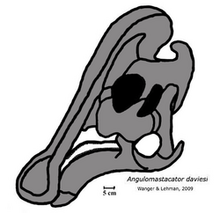Angulomastacator (meaning "bend chewer", in reference to both the shape of its upper jaw and to the Big Bendarea of the Rio Grande, where the type specimen was found) is a genus of duck-billed dinosaur from the Late Cretaceous, Aguja Formation of Big Bend National Park, Texas.
Description[]

It is known from a single specimen, TMM 43681–1, a partial leftmaxilla (the main tooth-bearing bone of the upper jaw). This bone is curved down approximately 45° at its anteriorend, with the tooth row bent to fit, unlike any other hadrosaur. The unusual characteristics of the maxilla, which have not been reported from elsewhere, supports the hypothesis that the dinosaurs of the Aguja Formation were endemic forms. It was discovered in the upper shale member of the Aguja Formation, among plant, bone, and clam fragments in a bed interpreted as the deposits of a small tributary channel. This bed is just below rocks of the overlying Javelina Formation. Volcanic rocks at about the same level have been dated to 76.9 ± 1.2 million years ago.
Angulomastacator is classified as alambeosaurine, the group of hadrosaurs with hollow cranial crests. It was described in 2009 by Wagner and Lehman in 2009. The type species is A. daviesi, named for Kyle L. Davies, who in 1983 was the first to postulate the presence of a lambeosaurine in the Aguja Formation. As a hadrosaurid, Angulomastacator would have been abipedal/quadrupedal herbivore, eating plants with sets of ever-replacing teeth stacked on each other.